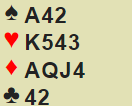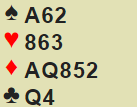AuthorOne of the strangest notions I have ever heard about -- somewhat out of fashion nowadays, I believe ... ... is the technique of, upon seeing your partner open 1NT and an opponent interfere with a natural overcall, bidding 3NT denying a stopper in the suit of the interference! If opener also lacks a stopper, the search for an adequate trump fit will begin at the 4-level. Why waste so much space? In my opinion, this is akin to jumping into a tumultuous ocean, yelling "Help me!" There are many more convenient ways to deal with this situation, while reserving the direct 3NT bid for the more natural meaning that promises a stopper. Negative doubles, 2NT with some artificial meaning, cuebids, transfers, are all available and it is easy to pick a specific sequence to denote the stopperless hand that wishes to force to game without searching for a major suit fit. There are two other ideas which, unlike the first exhibit, are quite widespread nowadays, and which deserve a closer look: opening any balanced hand with a weak NT range with 1 Club (1 Diamond being always unbalanced); and opening 1NT with 14-16. Opening always with 1 Club if you have a weak NT-type of hand is of course greatly beneficial when it does not happen. Knowing that the 1 Diamond opening guarantees an unbalanced hand, i.e., a 5 card suit (or a 4-card suit in a 4441 hand, which complicates matters a bit...), is quite comfortable. On the other hand, it is important to take into account the possible loss you incur by not opening with 1 Diamond hands such as these: Or even: Hiding your diamond suit with these hands will obviously hamper the fight for the partscore and, more importantly, partner's opening lead if the opponents win the auction.
I have never seen a detailed cost-benefit analysis of this style, and therefore I am skeptic of its effectiveness. If someone has made such an analysis, I would like to get acquainted with it. The second case, that of opening 1NT with 14-16 hands, has a terrible side effect: it consolidates, in the same opening, hands which too different strengths. Hands with 16 hcp are much more powerful (in a trick-taking sense) than hands with 14 hcp. A recent quick simulation, involving 1000 hands and double dummy play, pointed out that if you have a nondescript balanced 9 hcp hand, you will make 9 or more tricks 35% of the time, whenever partner has 15 hcp. If he has 16 hcp, the odds jump to 51%. That's a remarkable increase! Including the 14 hcp hands in your notrump opening becomes hard to manage -- and, from my vantage point, without a corresponding profit. In conclusion, I will go on a limb and say that these notions look more like fads, and are destined to be abandoned soon.
0 Comments
Leave a Reply. |
Archives
September 2021
Categories
All
|



 RSS Feed
RSS Feed